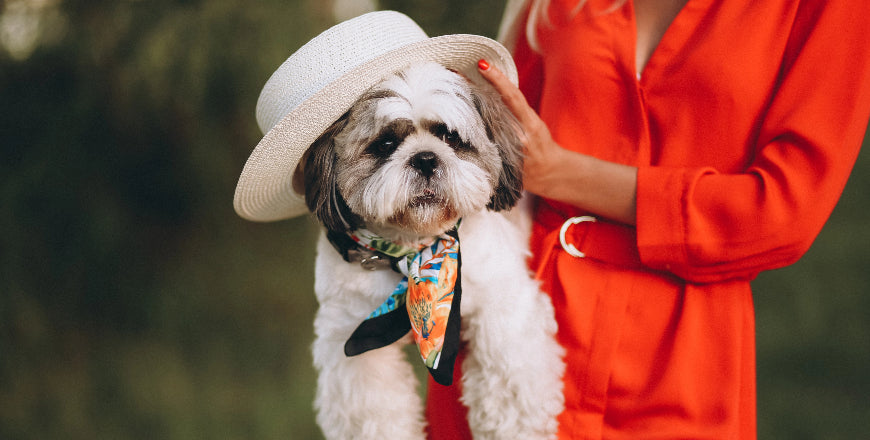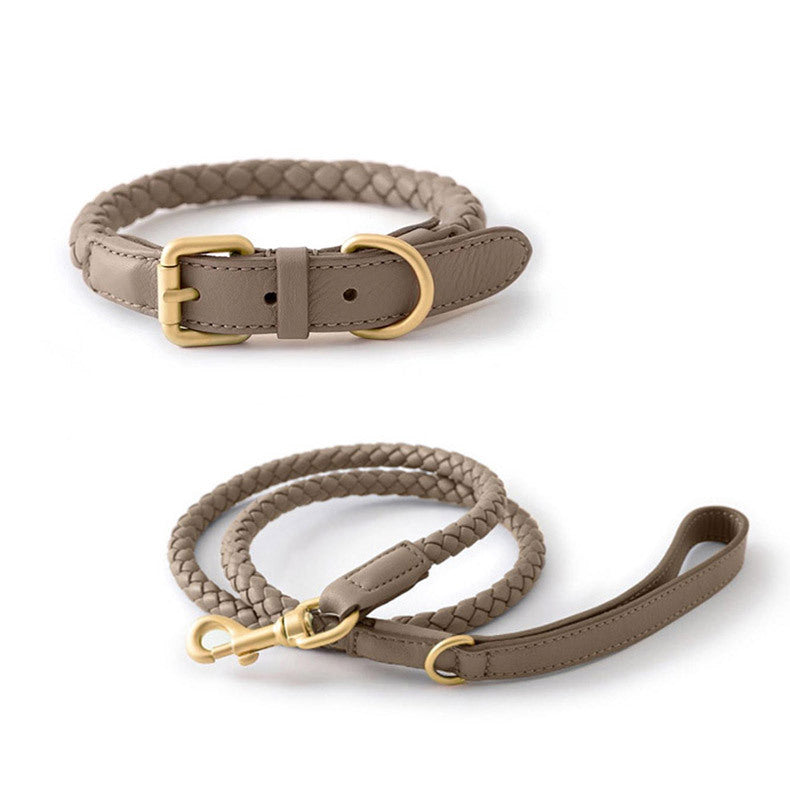
How Tight Should a Dog Collar Be
Share
A well-fitted dog collar is a fundamental piece of safety equipment for your pet. However, achieving the correct collar fit is critical. An improperly sized collar can pose significant risks. One of the most common and serious dog collar dangers is a collar that is too tight, which can cause neck injuries, skin irritation, and breathing difficulties for a dog.
Why is the correct tightness of a collar so crucial
Your dog's collar is an essential tool for their safety and your peace of mind. But just like an uncomfortable pair of shoes, a poorly fitted collar does more than just irritate; it can lead to real health and safety issues.
A collar that is too tight can put constant pressure on your dog's neck. Over time, this can lead to collar-related injuries, such as skin irritation, fur loss, and even breathing difficulties. On the other hand, a collar that is too loose is a safety risk, as it can easily slip off, potentially leading to a lost pet.
Understanding the importance of a proper collar fit is the first step in preventing these collar safety issues and ensuring your dog is both safe and comfortable.

The danger of a collar being too tight
A collar that is too tight often causes harm gradually, making the problem easy to overlook. The risks, however, are significant. This is especially critical for puppies, as their rapid growth means the collar fit must be checked and adjusted frequently to avoid constricting their necks.
Damage to the Trachea and Breathing
Constant pressure from a tight collar can lead to chronic health issues.
Symptoms: You may notice persistent coughing, wheezing, or labored breathing, particularly when your dog is excited or pulls on the leash.
Serious Consequences: In severe cases, this can contribute to tracheal collapse, a serious and often irreversible condition, especially in high-risk breeds like Poodles, Chihuahuas, and Yorkshire Terriers.
Skin and Coat Injuries
A tight collar creates friction, leading to visible discomfort and injury.
Skin Problems: This chafing can cause hair loss, red skin, sores, and ulcers, creating openings for bacterial or fungal infections.
Permanent Damage: Over the long term, the sustained pressure can permanently prevent hair from growing back, leaving a visible mark on your dog's neck.
Restricted Blood Flow and Nerve Pressure
The neck is a vulnerable area filled with vital structures.
Circulation: An overly tight collar can compress blood vessels, impairing healthy blood circulation to the head and neck.
Nerves: It can also press on nerves, potentially causing pain, muscle weakness, or unusual sensations. A dog may become head-shy, irritable, or resistant to having its neck touched.
Potential Impact on Thyroid Function
Some veterinary studies suggest a potential long-term risk. The constant pressure on the neck may interfere with blood flow to the thyroid gland, which could be a factor in the development of hypothyroidism.
Development of Behavioral Issues
Discomfort can create negative associations.
When a collar causes pain, a dog may start to connect that feeling with walks, going outside, or being handled. This can lead to fear, resistance, or even aggressive behavior.
This is often exacerbated when a dog pulls strongly on the leash and the owner pulls back, creating a cycle of pressure and discomfort.
The risk of a collar being too loose
While a tight collar poses health risks, a loose one presents immediate dog safety hazards. The primary danger is that a poorly fitted collar can easily slip off, turning a moment of excitement into a crisis.
Escapes and Lost Pets
The most common risk of a loose collar is escape. If a dog is startled, excited, or chases something, the collar can slide over its head. This dramatically increases the risk of your dog getting lost, leading to potential traffic accidents, injuries, or poisoning in an unfamiliar environment.
Snagging and Entrapment
A loose collar has extra material that can easily catch on objects like tree branches, fence posts, or furniture. A particularly serious hazard occurs if a dog's jaw becomes trapped in the loose collar while scratching or exploring. This can cause panic and struggling, which may tighten the collar and lead to choking.
Hinders Leash Training and Control
A properly fitted collar is essential for effective communication. A loose dog collar fails to transmit clear signals through the leash, making it difficult to guide your dog or correct unwanted pulling behavior. This can undermine your leash training efforts and make walks less manageable.
Lost Identification
A collar carries your dog's most important safety feature: its ID tags. If the collar comes off, your dog loses its immediate form of identification, significantly delaying a safe return home should it become lost.
Conclusion: The Key is a Proper Fit
Both tight and loose collars carry significant risks. Mastering the simple "two-finger rule" for checking collar fit is a fundamental responsibility for every dog owner, ensuring your pet remains safe, secure, and identifiable at all times.

What is the Two-Finger Rule for Dog Collars
The "Two-Finger Rule" is a simple, vet-recommended method to check your dog collar fit. It helps you ensure the collar is snug enough for safety but loose enough for comfort, preventing both choking hazards and the risk of escape.
The Core Method
After fastening the collar, you should be able to comfortably slide two fingers (your index and middle fingers) between the collar and your dog's neck. This quick check is a fundamental part of responsible dog ownership.
How It Manages Risk
This technique effectively balances two key concerns for collar safety:
Security: It confirms the collar is sufficiently tight so it won't slip off over your dog's head during walks or play.
Comfort: It verifies there is enough space to avoid putting harmful pressure on your dog's neck and trachea.
How to Check the Fit Using the Two-Finger Rule
Follow these simple steps to accurately assess your dog's collar fit and ensure their safety and comfort.
Secure the Collar
Start by fastening the collar on your dog at your best guess for a proper fit.
Locate the Right Spot
Feel for the space between the collar and your dog's neck. The top or upper side of the neck is often the best place to check.
Slide Your Fingers In
With your index and middle fingers held together, gently slide the fingertips underneath the collar until they rest against your dog's skin. Your fingers should lay flat and slide in smoothly without any forceful prying.
Assess the Feel
Pay close attention to the sensation. You are checking if there is a snug but comfortable fit that allows for easy movement of your fingers.
Judgment Criteria: Finding the Perfect Fit
Use the following criteria to interpret what your two fingers tell you about your dog's collar fit.
A Perfect, Snug Fit
What it feels like: Two fingers slide in and out easily against your dog's skin, meeting slight, gentle pressure but no resistance.
What it means: This is the ideal safe and comfortable fit. The collar is secure enough to prevent slipping off, yet loose enough to avoid causing any discomfort or pressure on the neck.
The Collar is Too Tight
What it feels like: You cannot slide your fingers in at all, or you must force them underneath the collar.
What it means: The collar is dangerously tight and poses a risk to your dog's health. You should loosen the collar immediately until you can easily fit two fingers beneath it.
The Collar is Too Loose
What it feels like: You can fit more than two fingers easily underneath, or there is a very large, noticeable gap.
What it means: The collar is not secure and your dog could potentially slip out of it. Tighten the collar until you achieve the proper two-finger fit to ensure your pet's safety.
Mastering this simple check is a key part of responsible dog ownership, helping you maintain the correct collar fit for your dog's well-being on every walk.
Conclusion
Ensure a Safe and Comfortable Fit. Mastering the two-finger rule is a fundamental skill for every dog owner. This simple, reliable method takes the guesswork out of finding the right collar fit, directly addressing both collar safety and your dog's comfort. By performing this quick check regularly, you actively prevent the risks of a collar that is too tight or too loose.
Making this check part of your routine is a simple yet powerful way to protect your pet. It ensures that your dog's collar remains what it should always be: a secure point for a leash and ID, never a source of discomfort or danger. This small habit is a core part of responsible dog ownership, giving you peace of mind and contributing to your dog's long-term well-being.

